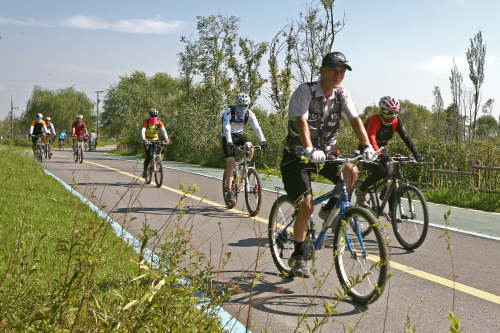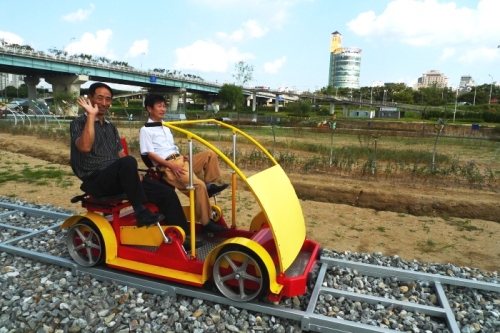Seoul’s major river parks offer ideal routes for cyclistsThe weather is warming up, and many Seoulites are heading for the water. The Han River, in particular, offers plenty of ways to stay cool while having fun. From inline skating to fishing to water skiing, there are countless ways to enjoy the river and its surroundings. Yet for those who are environmentally-minded and want to stay active, bike riding would be the best way to appreciate the city’s riverside and its beautiful scenery. There are a total of 12 Han River Parks across Seoul, all connected to each other. Here are some scenic routes you can take between them.

People ride their bikes at Nanji Han River Park in Seoul. (The Hangang Project Headquarters)
Nanji Park is the place where one can appreciate nature most. Enjoy the scenery while making your way to Mangwon Park from Nanji, following the beautiful river path. Once you arrive in Mangwon Park, you’ll be welcomed by a trail along the riverside which is about 1 kilometer long. If you want a short break from your ride, this trail is a great place to relax and stroll for a bit. Once you are done with Mangwon, it’s time to cross Mapo Bridge. Having a wide separate road for cyclists, the bridge safely connects many riders from Mangwon Park to Yeouido Han River Park and vice-versa. Yeouido Park has water fountains, a water square and a large open space where various cultural events are held almost every weekend. If you’d like to go further from Yeouido, make your way to Dongjak Bridge. The bridge has two cafes ― Cafe Goolum (meaning Cloud) and Cafe Noeul (meaning sunset) which many people visit for a night view of the river.

People ride rail bikes at Gwangnaru Han River Park in Seoul. (The Hangang Project Headquarters)
Gwangnaru Park offers a special program where visitors can try out many different kinds of unique bikes. There are rail bikes ― where the bikes are attached to rail tracks on the ground ― lying bikes, bikes with square-shaped wheels, and bikes that have toilet-like seats. It costs 1,000 won an hour to hire these strange bikes. The park also runs a separate ground for children who’d like to learn how to ride a bike, and a racing track for both professionals and amateurs. In order to ride on the racing track, one has to go through safety training. Once you are done with all the fun-looking bikes, take off to Banpo Park, which takes about two hours riding along the river path. If you need a break in between, stop by Hannam Bridge for its famous “Cafe Rainbow.” Aside from the pretty view of the Han River it offers, the caf is also bike-friendly. It has a separate space where riders can safely place their bikes while enjoying the view over their drinks. For more information on Gwangnaru Park and its special bikes, call (02) 3780-0501.
Route 3: Ttukseom Han River Park to Amsa Ecological History Park
If you’d like to eat, watch exhibitions, and enjoy river views all in one place, check out Ttukseom Han River Park and its cultural complex named “J-Bug.” Conveniently located near Ttukseom Resort Station, the complex offers a venue for amateur artists to exhibit their work. It also houses cafes, gift shops and restaurants. Aside from J-Bug, Ttukseom Han River Park has music fountains, a riverside square, a rose garden, playground and a nature learning center. Just like the one in Yeouido, Ttukseom Park is a popular venue for many cultural events and performances in Seoul. Its Saturday Flea Market is notably popular. After enjoying your stay at Ttukseom, hop back on your bike and start pedaling toward the upper stream of the Han River. This road is surrounded by willow trees and is relatively easy to ride as it has many downward paths. Once you cross Gwangjin Bridge, you’ll soon arrive at Gwangnaru Han River Park. From Gwangnaru, pedal for about a kilometer toward the upper stream of the river. You’ll soon see a giant forest that leads to Amsa Ecological History Park. With long winding trails surrounded by the beautiful plants of the Han River, this large scenic park is ideal for bike riders wishing to see the river’s living animals and plants. There are wild roses, loosestrifes, and tiger lilies, along with Korea’s migratory birds. If you’d like, ride back to Ttukseom Park by crossing Jamsil Bridge this time. There is a famous lookout cafe named “Riverview Bom” on the bridge, where one can enjoy the fantastic night view of the Han River.
Route 4: Gangseo Park to Seonyudo Park
While eastern Seoul is home to Amsa Ecological Park, Gangseo Marsh Ecological Park is located in the western part of the city. The eco-park is located near Gangseo Han River Park, and consists of low wetlands and freshwater lakes. Start pedaling toward Yanghwa Bridge. The bridge connects you from the mainland to a small island called Seonyudo. The island and its Han River park offer many classes on Seonyudo’s nature and animals. It is also a great place to walk and relax with the river flowing near you. Yanghwa bridge also has a lookout cafe named Cafe Aritaum. You might want to drop by on your way back home.
If you don’t own a bike …
Seoul’s Han River parks offer rental services for those who do not own their own bike. While there are four Han River parks in northern Seoul Ttukseom, Ichon, Mangwon and Nanji ―, southern Seoul has eight parks near the river: Gwangnaru, Jamsil, Seonyudo, Yeouido, Jamwon, Banpo, Yanghwa and Gang-seo. All of these parks, except for the one in Seonyudo, run bike rental shops. The rental rate is 3,000 won per hour and ID is required. On weekdays, bikes can be returned to any of the rental shops at the 11 Han River parks across Seoul, without having to going back to where it was rented. On the weekends, however, the bikes must be returned to the original shop. They open every day at 9 a.m. and close at 6 p.m. For more information on bike rentals, call (010) 993-4440.
By Claire Lee (
dyc@heraldcorp.com)







![[Graphic News] More Koreans say they plan long-distance trips this year](http://res.heraldm.com/phpwas/restmb_idxmake.php?idx=645&simg=/content/image/2024/04/17/20240417050828_0.gif&u=)